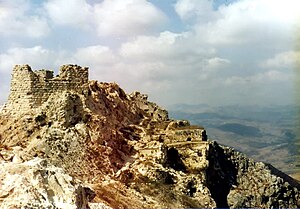Beaufort Castle (Lebanon)
| Beaufort Castle | ||
|---|---|---|
|
Beaufort above the Bekaa plain (1982) |
||
| Alternative name (s): | Belfort Castle; Qalaat al-Shaqif Arnun | |
| Creation time : | before 1139 | |
| Castle type : | Hilltop castle | |
| Conservation status: | ruin | |
| Standing position : | Barons | |
| Place: | Deir Mimas | |
| Geographical location | 33 ° 19 '29 " N , 35 ° 31' 55.7" E | |
| Height: | 650 m | |
|
|
||
The Beaufort Castle , and Belfort Castle called Arab Qal'at al-Schaqīf Arnūn /قلعة شقيف أرنون, is about 650 m high above the Litani River in southern Lebanon , across from Deir Mimas .
Building the castle
The east side of Beaufort is protected by a vertical rock fall on the river side. The protection on the north side consists of a trench carved into the rock. A two-story donjon from the 12th century in the middle of the west side protects this part of the courtyard. Between 1190 and 1240 an Arab fort was built on the north side , which is connected to the main castle by a wall .
history
The fortress was conquered in 1139 by King Fulk of Jerusalem , who had the castle expanded. The road between Tire and Damascus could be controlled from the castle .
The Counts of Sidon held the castle from 1139 to 1190 before it was conquered by Muslim troops.
Beaufort was the only larger crusader castle that withstood the wave of conquests of Saladin from 1187 to 1189, which besieged the castle several times. The lord of the castle, Rainald von Sidon , tricked Saladin by promising handover, but secretly repairing the castle. On April 22nd, 1190 he finally had to hand over the castle to Saladin against free withdrawal of the defenders to Tire.
During the crusade of Count Theobald IV of Champagne , Balian of Sidon received the castle back in 1240 from the Ayyubid Sultan of Damascus as-Salih Ismail , who sought the support of the crusaders against his nephew al-Salih Ayyub , the Ayyubid Sultan of Egypt , hoped. Contrary to the orders of their own sultan, the Muslim occupation of the castle refused to hand it over to the Christians, whereupon as-Salih Ismail besieged the castle himself with his army and forced it to be handed over to the crusaders. Other troops of as-Salih Ismail also refused to fight alongside the crusaders against Muslims, so that the crusaders instead finally accepted an offer from the Sultan of Egypt in the winter of 1240/41 to conclude a neutrality agreement with him against further territorial cessions. At this point the castle had already been handed over to the Christians and remained in their possession.
When the Mongols later devastated the area around the castle, Balian sold it to the Knights Templar in 1260 , who carried out further extensions to the castle.
On April 15, 1268, the castle was lost to the crusaders when they had to surrender under Sultan Baibars I to the Mameluke troops who had overthrown the Ayyubids in Egypt after a 10-day siege . Women and children were allowed to move freely to Tire , but all men were enslaved. The castle itself was repaired by the Baibars and occupied with a strong garrison.
In the 17th century the Lebanese prince Fakhr ad-Din II used the castle as part of his fortress network. Fakhr ad-Din was eventually defeated by the Ottomans , who destroyed the upper part of the castle.
In 1782 the governor of Akkon captured the castle and destroyed part of the remaining fortifications.
In 1837 the remains of the castle were badly damaged by an earthquake . From then on the castle was used as a quarry and sheepfold.
The restoration of the castle began in 1920 under the French mandate administration and continued after 1943 by the now independent state of Lebanon .
The strategic location of the castle, which allows a view over large parts of southern Lebanon and northern Israel, has made the castle hill a coveted bone of contention up to the present day . In 1982 the Israeli army captured the mountain in southern Lebanon during the Lebanon War . In 2000, she withdrew from southern Lebanon after public protests. This military action is the theme of the Israeli film Beaufort . The Israeli army felt compelled to blow up the castle when it withdrew and thus largely destroyed its historical substance. Appeals from the UN and the Lebanese government to stop the destruction were not met.
Individual evidence
- ↑ See Steven Runciman : History of the Crusades. Special edition in one volume without references to sources and literature, 28. – 32. Thousands of the total print run. CH Beck, Munich 1995, ISBN 3-406-39960-6 , p. 1103.
literature
- Chris Gravett: Atlas of Castles. The most beautiful castles and palaces. Tosa, Vienna 2001, ISBN 3-85492-470-4 , p. 156.
- Hugh Kennedy: Crusader Castles. Cambridge University Press, Cambridge 1994, ISBN 0-521-42068-7 .
- Ron Leshem : If there is paradise. Novel. Rowohlt, Berlin 2008, ISBN 978-3-87134-588-3 .
- David Nicolle : Crusader Castles in the Holy Land 1097-1192 (= Fortress. 21). Illustrated by Adam Hook. Osprey Publishing, Oxford 2004, ISBN 1-84176-715-8 .
- Raymond C. Smail: Crusading Warfare (1097-1193). (= Cambridge Studies in Medieval Life and Thought. NS 3, ISSN 0950-6314 ). Cambridge University Press, Cambridge et al. 1956.
Web links
- Pierre Grussenmeyer, Jean Yasmine: The Restoration of Beaufort Castle (South Lebanon) A 3D Restitution According to Historical Documentation . Lebanese Directorate General of Antiquities (English; PDF file; 348 kB) ( Memento from September 27, 2007 in the Internet Archive )
- Beaufort Castle, Lebanon (English)

